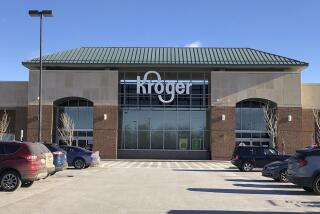Macy Built Retailing Empire on Its Flair for Marketing
- Share via
R. H. Macy & Co., the mecca of merchandising for generations of Americans, opened its doors in New York 130 years ago as the fifth retailing attempt by a four-time loser.
Of his first failed venture, Rowland Hussey Macy wrote in his diary: “I have worked for two years for nothing. Damn, Damn, Damn, Damn.”
Even the fifth attempt started poorly: Just $11.06 was rung up on the first day of business in New York in 1858.
But with a flair for advertising and aggressive marketing that has persevered to this day, Macy’s grew to become one of the nation’s largest department store chains and a national cultural symbol whose annual Thanksgiving Day parade is as much a part of the holiday as is the turkey itself for millions of people.
Macy’s, which operates about 90 stores from its flagship on Herald Square in New York to its trendy Union Square store in San Francisco, is now poised to reach yet another retailing milestone: a merger with giant Federated Department Stores.
On Monday, Macy’s acknowledged that it is the so-called mystery bidder that emerged over the weekend for Federated’s widespread operations, which include the Bullock’s, I. Magnin, Bloomingdale’s and Filene’s department store chains.
If Macy’s bid is successful, it would give the company at least one of the prizes it has sought in recent years: a presence in Southern California, particularly in the affluent sections of Orange and Los Angeles counties, in the form of Federated’s fashionable Bullock’s and Bullock Wilshire department stores.
And the major beneficiary, say analysts, would be the everyday department store shopper.
If Macy’s were to take over operation of the 29 Bullock’s and Bullock Wilshire stores, the change could be dramatic, said Thomas Tashjan, vice president of retailing for Seidler Amdec Securities in Los Angeles.
“Macy’s and Bullock’s are both upscale chains,” Tashjan said. “But Macy’s is far more promotional. They turn more merchandise through the store and they have become more service-oriented in recent years. The consumer will be the victor.”
Monroe Greenstein, a retailing analyst at Bear, Stearns & Co. in New York, said Macy’s would offer more formidable competition to Southern California retailers than they have experienced in recent years. “Macy’s would give Nordstrom its first real competition down there,” Greenstein said. “Nordstrom has been running away almost unchecked since they arrived.”
Macy’s is perhaps best known for making theatrics an acceptable and even necessary part of retailing.
And the man most credited for turning Macy’s into a shopper’s theater is its chairman and chief executive, Edward S. Finkelstein, who has spent his entire working life at Macy’s.
Finkelstein, 62, made his mark as head of Macy’s California division in the late 1960s, when he turned around the sagging operations at the chain’s large downtown San Francisco store. His first step was to transform’s the store’s dingy basement housewares department into a culinary showcase dubbed the Cellar. Later, the rest of the store was gradually given a modern face lift of bright new decore and trend-setting merchandise.
Within several years of his arrival, Finkelstein, who was willing to lavish money on store interiors and spend aggressively on promotions, had boosted Macy’s San Francisco store into first place in that city’s retail hierarchy and attracted a wide audience among upscale, fashion-conscious shippers.
‘Finest Management’
According to Tashjan, Macy’s now enjoys sales of more than $200 per square foot of retailing space in its San Francisco emporium on Stockton Street, a healthy measure for a general department store.
In 1974, Finkelstein brought his game plan to the East Coast as president of Macy’s New York division. Again, his strategy worked, and Macy’s was transformed from a tired chain into an exciting retailer that was quickly copied by its rivals, particularly Bloomingdale’s.
An often-cited example of Finkelstein’s marketing flair was his decision to install a replica of the famous 3rd Avenue saloon and restaurant P. J. Clarke’s in the flagship, 11-story emporium on 34th Street at Herald Square.
“Macy’s has one of the finest management teams in all of retailing,” Greenstein said. “They would be a real asset to Federated operations.”
Main story, Part I, Page 1
MACY’S IN CALIFORNIA
R. H. Macy & Co., a national retail giant with sales of $5.2 billion in 1987, operates 25 Macy’s stores in Northern California, from San Francisco to Fresno, and Nevada.
The company has no outlets in Southern California. Last year, however, the company confirmed that it had plans to build a store in Marina del Rey and was considering several store sites in Orange County.
More to Read
Inside the business of entertainment
The Wide Shot brings you news, analysis and insights on everything from streaming wars to production — and what it all means for the future.
You may occasionally receive promotional content from the Los Angeles Times.










